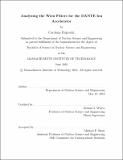Analyzing the Wien filters for the DANTE ion accelerator
Author(s)
Ruprecht, Carolena
DownloadFull printable version (737.8Kb)
Other Contributors
Massachusetts Institute of Technology. Department of Nuclear Science and Engineering.
Advisor
Dennis G. Whyte.
Terms of use
Metadata
Show full item recordAbstract
Materials used in nuclear reactors, both fission and fusion, are continuously interacting with high energy ions. Tandem electrostatic accelerators, such as DANTE, are able to produce ions at high energies that can be used to simulate these interactions. In order to enhance the quality of experimental data taken using an accelerator, it is useful to ensure that the particles being accelerated are of the same species. Wien filters use electromagnetic forces to filter particles in an ion beam. Also referred to as mass selectors or velocity selectors, Wien filters operate on the principles of the Lorentz force in order to select ions of a certain mass while filtering out all others. The Wien filters in DANTE were modeled and tested in order to determine their effectiveness and ideal operating conditions. Experimental data was taken by varying the voltage applied to the Wien filters operating in DANTE. Preliminary results concluded that the Wien filters are able to steer the beam, as demonstrated by the impact of Wien filter voltage on the beam current through the accelerator. However, the experiment was inconclusive as to whether or not the Wien filters successfully filtered out unwanted ions. The settings applied during the experiment were then simulated with a model. For a deuterium beam, the model recommends voltage settings of 312 V and 341 V for the horizontal and vertical Wien filters, respectively. The model results are consistent with the experimental data. Recommendations for future work on this project are outlined following the results.
Description
Thesis: S.B., Massachusetts Institute of Technology, Department of Nuclear Science and Engineering, 2016. This electronic version was submitted by the student author. The certified thesis is available in the Institute Archives and Special Collections. Cataloged from student-submitted PDF version of thesis. Includes bibliographical references (page 45).
Date issued
2016Department
Massachusetts Institute of Technology. Department of Nuclear Science and EngineeringPublisher
Massachusetts Institute of Technology
Keywords
Nuclear Science and Engineering.